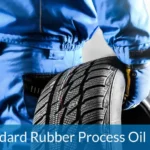🛢️ Use of Rubber Process Oil in Rubber Manufacturing & Industrial Applications
Rubber Process Oil (RPO) plays a key role in manufacturing rubber-based products. This petroleum-derived compound is specially formulated to boost the workability, durability, and flexibility of rubber. Consequently, industries such as automotive and construction widely use it. In these sectors, RPO acts as a processing aid, softener, and cost reducer.
Indeed, Rubber Process Oil remains essential in producing tires, footwear, molded parts, and conveyor belts. It comes in different grades depending on the rubber type used—whether natural rubber (NR), synthetic rubber (SBR, EPDM, BR), or reclaimed rubber.
🧪 What is Rubber Process Oil?
Rubber Process Oil refers to a refined mineral oil that improves the mixing and shaping of rubber compounds. Manufacturers extract it from petroleum through distillation followed by refining. Since it reduces viscosity and distributes fillers like carbon black more evenly, it creates rubber products that remain flexible, durable, and easy to mold.
There are four main types of RPO, categorized by their chemical makeup:
-
Aromatic RPO – Offers high solvency, ideal for NR, BR, and SBR rubbers.
-
Paraffinic RPO – Provides low solvency but great oxidation resistance.
-
Naphthenic RPO – Delivers balanced performance and compatibility.
-
Green RPO – Contains low PAHs and is environmentally safe.
⚙️ Composition and Types of Rubber Process Oil
| Type | Solvency | Color | Viscosity (Cst @ 100°C) | Common Applications |
|---|---|---|---|---|
| Aromatic RPO | High | Dark | 30–70 | Tires, automotive parts |
| Naphthenic RPO | Medium | Light | 20–60 | Seals, hoses, shoes |
| Paraffinic RPO | Low | Pale | 20–50 | Industrial sheets, wires |
| Green RPO | Med–High | Light | 25–55 | Eco-safe rubber goods |
Aromatic oils, because of their strong solvency, work exceptionally well with carbon black. Therefore, they suit tire treads and high-load rubber perfectly. Conversely, naphthenic and paraffinic types fit light-colored products that demand thermal and oxidation resistance.
Moreover, manufacturers use different process oils to meet specific industrial needs:
➤ Paraffinic Process Oils
These oils come from petroleum with high saturates and low aromatics. They provide excellent color stability and suit applications requiring low volatility, such as tire production.
➤ Naphthenic Process Oils
Offering better solvency than paraffinic types, these oils fit rubber used in footwear, belts, and seals. Additionally, they ensure good low-temperature performance.
➤ Aromatic Process Oils
Preferred for heavy-duty applications, aromatic oils contain higher aromatics. They blend easily with fillers and serve well in treads and molded rubber parts.
➤ Treated Process Oils
Refined or hydrogenated to enhance properties like stability, color, or PAH content, treated oils help manufacturers meet modern safety and performance standards. Hence, many choose treated oils today.
🔧 Function and Benefits of Rubber Process Oil
Rubber Process Oil delivers several performance advantages during rubber compounding and shaping:
-
It improves processability by lowering viscosity, making mixing and molding easier.
-
It enhances filler dispersion to ensure even mixing of fillers like carbon black or silica.
-
It boosts flexibility by increasing softness and elongation in final products.
-
It improves heat resistance, protecting rubber from brittleness under heat.
-
It reduces costs by acting as a cheaper extender for rubber blends.
Let’s explore more specific roles RPO plays:
🔹 Plasticization
RPO softens rubber, allowing it to flow better during processing.
🔹 Viscosity Control
By controlling viscosity, RPO ensures smoother mixing and uniform results.
🔹 Compatibility
RPO improves the bond between rubber ingredients and fillers.
🔹 Extrusion and Flow
RPO enhances mold flow, helping produce defect-free components.
🔹 Thermal Stability
It protects rubber compounds from premature degradation during processing and end use.
🏭 Industrial Applications of Rubber Process Oil
Rubber Process Oil finds use in a wide range of industries. Below are some key applications:
🚗 Tire Industry
RPO improves rubber flow into molds, boosts wear resistance, and manages heat buildup. As a result, tires last longer and perform better.
🏗️ Industrial Rubber Products
Hoses, gaskets, and vibration mounts benefit from RPO because it improves elasticity and maintains strength under stress.
🧴 Adhesives and Sealants
RPO softens sealants and adhesives, improving sticking power and long-term flexibility in automotive and construction projects.
👞 Footwear Manufacturing
Shoe soles and midsoles incorporate rubber mixed with RPO to stay flexible, durable, and comfortable for daily wear.
🛢️ Automotive Parts
Engine mounts, bushings, and seals use RPO to remain strong under extreme temperature changes.
🧰 Cables and Insulation
Electrical cables and insulation sheaths require flexibility and oil resistance, both of which RPO helps deliver.
🌱 Advantages of Using Rubber Process Oil
-
It exhibits high compatibility with various rubber compounds.
-
It improves filler dispersion, ensuring uniform texture.
-
It enhances product softness and stretchability.
-
It provides resistance to oxidation and thermal aging.
-
Eco-friendly green rubber process oil options are available.
-
It proves cost-efficient for mass production.
❓ FAQs About Use of Rubber Process Oil in Industry
🔍 What types of Rubber Process Oils are available?
There are four main types: aromatic, paraffinic, naphthenic, and green (low-PAH). Each serves specific uses depending on performance and safety standards.
🧪 Why is RPO used in rubber compounding?
RPO enhances processability, disperses fillers, reduces stiffness, and adds flexibility to rubber compounds.
🛠️ Is Rubber Process Oil safe for manufacturing?
Yes, most RPOs comply with industrial safety standards. Green rubber process oils are even safer, featuring low PAH levels.
🧰 What role does RPO play in tire production?
It improves rubber flow in molds, promotes even filler distribution, and enhances rolling resistance and tire lifespan.
🌐 Is RPO environmentally friendly?
Green RPO complies with eco-regulations, contains minimal PAHs, and is safe for human use and the environment.
🧾 Conclusion – Use of Rubber Process Oil
Rubber Process Oil remains a vital ingredient in the rubber industry. Not only does it simplify manufacturing, but it also enhances the quality and lifespan of finished products. By improving flexibility, reducing production costs, and supporting eco-friendly options, RPO adds significant value to everything from tires to cables. Therefore, choosing the right RPO type optimizes performance and helps manufacturers meet both technical and environmental goals.
📣 Call to Pars Universal Bitumen – Partner with Sustainable Innovation
🔍 Are you actively searching for premium, eco-certified Rubber Process Oil solutions?
👉 Pars Universal Bitumen delivers exactly what your industry needs—efficient, safe, and sustainable:
✅ Low-PAH, REACH-compliant Green rubber process oil options
✅ De-aromatized and bio-based formulations
✅ Full technical support, SDS, and certification documents
✅ Flexible packaging and global delivery options
📞 Reach out to us today and take the next step toward eco-friendly production:
📧 Email: [email protected]
📞 Phone: +971 4 878 2031
🌐 Visit: Pub-ltd
🌱 Let Pars Universal Bitumen become your trusted partner in achieving cleaner, more sustainable rubber manufacturing. If You have any other Query or Question you want to ask, Please don’t hesitate to Contact Us.





